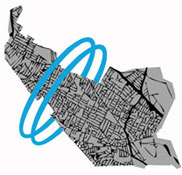
| Between February 2009 and December 2010, we spoke to hundreds of people about the future. A few dozen of these people were nice enough to make predictions about the future. Some of these predictions took the form of elaborate short stories, or intricate drawings or maps. Click on their names to see what these participants submitted to the project. (Note: to see these predictions in context, click on "Timeline & findings", above.)
|
By mid-century, Somerville's centuries-old two- and three-family homes were crumbling. This was due to a number of things. Homeowners hit by capitalism's swan-song couldn't afford repairs. Condo-owners not taking responsibility for the overall buildings' structures. Landlords only caring about rent checks, and not the units the rent checks were buying. In 2045, a series of collapses killed and hurts dozens of people. By 2048, it had become so common people would joke about it. Finally, in 2056, our speedy government decided to pass some laws, and all of the remaining buildings were knocked down. In 2058, the first of the new replacement buildings went up-tall green, energy-efficient mid-rises surrounded by parks. One building per 4 lots, with twice as much residential space. Hover cars, which had made their first appearance in the 2020s, had finally become affordable in the 2060s. The new replacement buildings were equipped with top-floor hover car parking garages. This, coupled with the new zip-wire technology, meant fewer and fewer people walked on the ground any more. Many wondered if this was a good thing. Also: 2015: My old landlady gives me my old apartment on Charnwood for free, because she misses me so much. (source: Tim Devin)
|